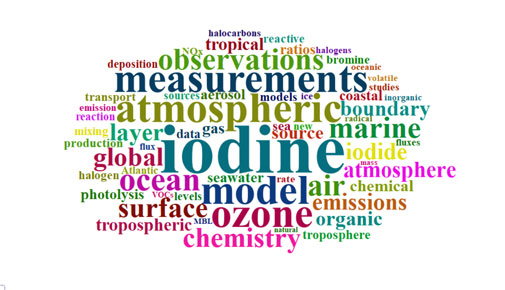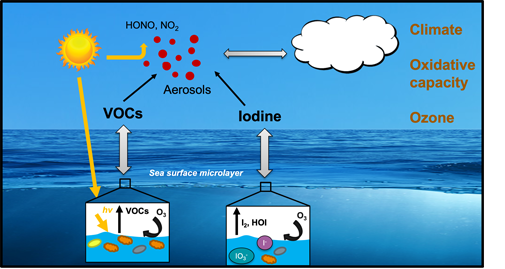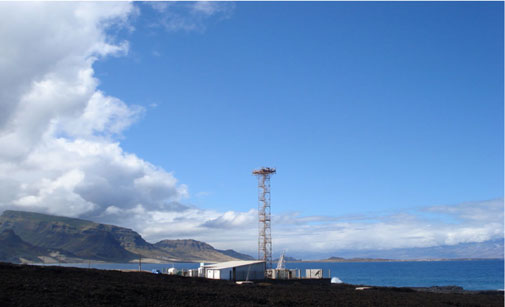Professor Lucy Carpenter MBE, FRS, FRSC
01904 324588
Email: lucy.carpenter@york.ac.uk
Atmospheric chemistry
Research Summary
My research group studies gas-phase tropospheric chemistry and multiphase chemistry occurring on ocean and aerosol surfaces and investigate the ocean-air emissions of gases affecting tropospheric and stratospheric chemistry. We make observations in the field, carry out laboratory experiments, develop instrumentation, and use models to improve our understanding of atmospheric chemistry and its impacts.

Current projects
Atmosphere-ocean interactions and atmospheric chemistry
Atmosphere-ocean interactions play a key role in regulating atmospheric composition and climate. We study the controls and mechanisms responsible for the release of a wide range of oceanic trace gases, including volatile halogens and volatile organic compounds, and the influence of these gases on atmospheric chemistry.

Diagram showing atmosphere-ocean interactions and atmospheric chemistry.
Oceanic ozone dry deposition
Ozone deposition to the ocean is an important but poorly quantified loss process for tropospheric ozone. Through field measurements of ozone fluxes by eddy covariance, laboratory measurements of ozone uptake to the ocean, and biogeochemical measurements in seawater, we are developing better understanding of the chemical and physical key drivers of this process and how it may also provide a source of atmospherically important trace gases to the marine atmosphere.
Long-term atmospheric composition
Lucy is the UK principal investigator of the Cape Verde Observatory (CVO) – a World Meteorological Organisation-Global Atmospheric Watch (WMO-GAW) global station. The University of York team has measured trace gases (O3, CO, NO, NO2, NOy, VOCs, halocarbons, mercury) at the station for nearly 20 years, supported by the Natural Environmental Research Council (NERC), allowing us to monitor global atmospheric trends and to study chemical processes occurring in the remote atmosphere

Photograph of the Cape Verde Observatory.
Selected Publications
- Extensive field evidence for the release of HONO from the photolysis of nitrate aerosols
Andersen, S., Carpenter, L. J., Reed, C., Lee, J. D., Chance, R., Sherwen, T., et al., Science Advances, 2023, 9, 3, doi:10.1126/sciadv.add6266 - Ground-Based Reactive Gas Observations Within the Global Atmosphere Watch (GAW) Network
Carpenter, L. J., Simpson, I. & Cooper, O., Handbook of Air Quality and Climate Change. Akimoto, H. & Tanimoto, H. (eds.). Singapore: Springer, 2022, p. 1-21. - Marine iodine emissions in a changing world
Carpenter, L. J., Chance, R. J., Sherwen, T., et al., Proceedings of the Royal Society A: Mathematical, Physical and Engineering Sciences, 2021, 477, doi:10.1098/rspa.2020.0824 - Scenarios and information for policymakers
Carpenter, L. J., Daniel J.S. (Lead Authors), E.L. Fleming, T. Hanaoka, J. Hu, A.R. Ravishankara, M.N. Ross, S. Tilmes, T.J. Wallington, D.J. Wuebbles, Chapter 6 in Scientific Assessment of Ozone Depletion: 2018, Global Ozone Research and Monitoring Project – Report No. 58, World Meteorological Organization, Geneva, Switzerland, 2018. - Alpine ice evidence of a three-fold increase in atmospheric iodine deposition since 1950 in Europe due to increasing oceanic emissions
Legrand, M., J. R. McConnel, S. Preunkert, M. Arienzo, N. Chellman, K. Gleason, T. Sherwen, M. J. Evans, L. J. Carpenter, Proc Natl Acad Sci U S A, 2018, 115, 12136-12141. - Chemistry and Release of Gases from the Surface Ocean
Carpenter, L. J. & Nightingale, P. D. Chemical Reviews, 2015, 115, 4015-4034. - Atmospheric iodine levels influenced by sea surface emissions of inorganic iodine.
L J Carpenter, S M MacDonald, M D Shaw, R Kumar, R W Saunders, R Parthipan, J Wilson and J M C Plane, Nature Geoscience, 2013, 6, 108-111. - Extensive halogen-mediated ozone destruction over the tropical Atlantic Ocean
K A Read, A S Mahajan, L J Carpenter, M J Evans, B V E Faria, D E Heard, J R Hopkins, J D Lee, S J Moller, A C Lewis, L Mendes, J B McQuaid, H Oetjen, A Saiz-Lopez, M J Pilling and J M C Plane, Nature, 2008, 453, 1232-1235. - Iodide accumulation provides kelp with an inorganic antioxidant impacting atmospheric chemistry
F C Küpper, L J Carpenter, G B McFiggans, C J Palmer, T J Waite, E-M Boneberg, S Woitsch, M Weiller, R Abela, D Grolimund, P Potin, A Butler, G W Luther III, P M H Kroneck, W Meyer-Klaucke and M C Feiters, Proc. Natl. Acad. Sci. (USA), 2008, 105, 6954-6958.

